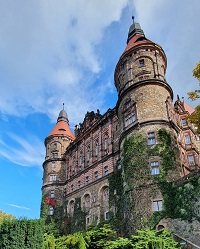Photo. Książ Castle, also called the Pearl of Lower Silesia, an amazing building built on a rock cliff - full of beautiful rooms, legends, tragedies and mysteries.
As the Nazi Germany began to fall in 1945 its leaders set about hiding the treasures they looted for the previous six years. One place can be benath Książ Castle.
Książ Castle, Polish: Zamek Książ, German: Fürstenstein, is the largest castle in the Silesia region, located in northern Wałbrzych in Lower Silesian Voivodeship as well as Poland's third largest castle behind only Malbork Castle and Wawel Castle. It lies within Książ Landscape Park, a protected area located in the Wałbrzyski Foothills. The castle overlooks the gorge of the Pełcznica river. The castle contains 400 rooms and occupies an area of approximately 11,000 square meters.
Watch photos on our tunnel on the Facbook page Travel Explorations.
The Książ Castle origins can be traced back to the 13th century when it was built by the order of Bolko I, the Duke of Lwówek. Since then, it was destroyed and rebuilt and expanded various times and in different styles (from Gothic to Baroque and neo-Classical) by the Bohemians and the last family to reside there, the Hochberg family, one of the richest and most influential families in Prussia. The Hochbergs lived there for many generations from the 16th century, when Konrad von Hochberg was granted the rights to the castle and the surrounding area, till 1944, when it was seized by the Nazis.
There are various theories about the real purpose of Książ Castle's undeground tunnels. As mentioed the during the Second World War, the castle was seized by the Nazi regime in 1944. One question is: did Nazis hide loot beneath this giant Polish castle? Situated more than 50 metres below the surface, the underground tunnels of the Książ Castle in Wałbrzych, southwest Poland, is an amazing construction work and still covers a big mystery.
Another theori is that Hitler’s bunker was to be located there. Other scientists believe that the place was to serve as a secret arms factory. It is also possible they served as a shelter for Nazi German officials. One thing is for sure: the incredible building work involves a great human tragedy.
Parts of this construction has been open to the public the previous years. As the chairman of the Książ Castle said in an interview: “We want to show that these underground tunnels are not about the legend of the "golden train" because that is what tourists usually ask us about it, but in fact, it is the tragic story of the Gross Rosen concentration camp prisoners, who dug up these tunnels on Hitler’s order. It is their story that is engraved on the walls of those tunnels” (source: TVP World, 16th October 2018).
This set the history in a another perspective than just focus on the purpose for building this huge underground complex. The Gross-Rosen concentration camp was a network of Nazi German concentration camps built and operated during WWII. The main camp was located in the village of Gross-Rosen, now Rogoźnica in southwestern Poland. At its peak activity, the population of all camps belonging to the network accounted for 11 percent of the total number of people incarcerated in the whole Nazi German system of concentration camps. Towards the end of the war, with the Red Army approaching fast, the Nazis destroyed much of the complex.
The tunnels that were dug during the Second World War and their real purpose is still unknown. After the war, only authorised persons belonging to the Polish Academy of Sciences (PAN) had access to the tunnels, in which seismographic equipment was installed.
The mystery of the purpose of building these tunnels and chambers from the Second World War lives on, but it is the tragic story of the Gross Rosen concentration camp prisoners we really need to think about. They dug up these tunnels on Hitler’s order. It is their story that is engraved on the walls of those tunnels. Keep in mind that the Nazis used thousands of prisoners as slave labour, many from concentration camps like Auschwitz, to build this amazing underground complex.
Stein Morten Lund, 28th September 2022
Additional information
Read more about the Nazi Gold Train.
Adolf Hitler and the Nazis are believed to have stolen billions of pounds worth of treasures in a struggle to fund the creation of a Fourth Reich. There are theories about hidingplaces in bunkers, chambers, tunnels, burried trains, benath castles, sunken shipwrecks in Atlantic, and dumped in lakes - from Europe to South America.
Some other legends of treasures hidden by the Nazis:
Could 16th century palace be hiding 28-tonnes of Nazi gold? SS diary reveals palace is one of five secret locations where Germans stashed WWII treasures (source: History, Stuart Dowell, 26the May 2020). According to the SS officer’s diary, the gold worth billions of euros is at the bottom of a disused well in the grounds of the Hochberg Palace in Roztoka, near Wałbrzych. The sensational claim comes from a war diary, written seventy five years ago by a Waffen SS officer under the pseudonym Michaelis, which describes the operation to hide treasure controlled by SS chief Heinrich Himmler at the end of the Second World War.
Theories about other places Nazi treasure could be found:
- Minkowskie, Poland
- Hartenstein Hills, Dresden, Germany
- Wrecks of SS Minden and MV Wilhelm Gustloff
- Berlin
- Patagonia, Argentina
- Dumped in Lake Walchen, one of the deepest and largest Alpine lakes in Germany. Located in the countryside near Munich. Aslo other lakes have been mentioned.












